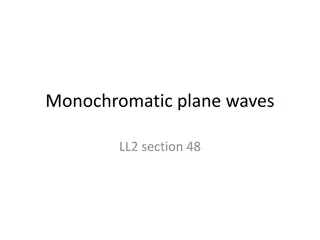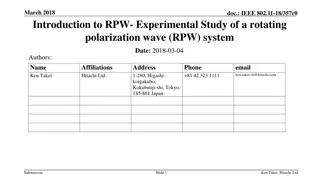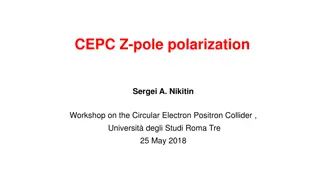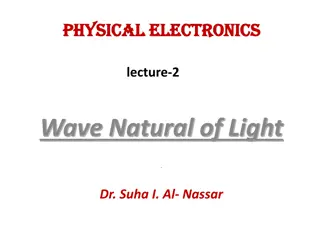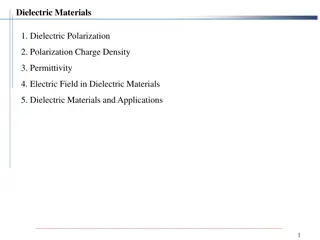Understanding Light Wave Polarization and Brewster's Law
Interference and diffraction phenomena demonstrate light as wave motion, leading to insights on wave nature. Maxwell's electromagnetic theory supports light as transverse waves. Learn about polarization of light waves, production methods, and applications in industry. Explore the discovery of light polarization by reflection and Brewster's Law revealing the angle of polarization in transparent media.
Download Presentation

Please find below an Image/Link to download the presentation.
The content on the website is provided AS IS for your information and personal use only. It may not be sold, licensed, or shared on other websites without obtaining consent from the author. Download presentation by click this link. If you encounter any issues during the download, it is possible that the publisher has removed the file from their server.
E N D
Presentation Transcript
Introduction: Interference and diffraction phenomena proved that light is a wave motion These phenomena are used to find wavelength of light and they do not give any indication regarding the character of waves. Interference and diffraction phenomena proved that light is a wave motion. Maxwell developed electromagnetic suggested that light-waves are electromagnetic waves. theory and
Electromagnetic waves are transverse waves, so it is obvious that light waves are also transverse waves. Longitudinal waves are waves in which particles of medium oscillate along the direction of propagation of wave (e.g. sound wave). Transverse waves are waves in which particles of medium oscillate perpendicular to the direction of propagation of wave. (e.g. Electromagnetic waves.) Polarization is possible in transverse wave
Unpolarized Light is the light is which the planes of vibration are symmetrically distributed about the propagation direction of the wave. Plane Polarized light is a wave in which the electric vector is everywhere confined to a single plane. A linearly polarized light wave is a wave in which the electric vector oscillates in a given constant orientation.
Production of Linearly Polarized Light: Methods for producing Linearly polarized light : 1. Reflection 2. Refraction 3. Scattering 4. Selective absorption 5. Double reflection. Applications of Polarized light: I. Industry and Engineering fields II. In liquid crystal displays (LCDs) III. Widely used in wristwatches, calculators, T.V. Screens IV. optical fibers.
Polarization by reflection: In 1808, E.L.Malus discovered the polarization of natural light by reflection from the surface of glass. He noticed that when natural light is incident on a plane sheet of glass at a certain angle, the reflected beam is plane polarized.
Brewster's Law In 1892, Brewster performed number of experiments to study the polarization of light by reflection at the surfaces of different media. He found that ordinary light is completely polarized in the plane of incidence when it gets reflected from a transparent medium at a particular angle known as the 'angle of polarization.' He proved that 'the tangent of the angle of polarization is numerically equal to the refractive index of the medium.' Also the reflected and retracted rays are perpendicular to each other.
If is the angle and is the refractive index of the medium, then This is known as Brewster s law.
Brewster found that the maximum polarization of reflected ray occurs when it is at right angles to the refracted ray. It means that According to Snell s law, Where, surface is the absolute refractive index of reflecting is the refractive index of the surrounding medium.
The polarizing angle is also known as Brewster angle and denoted by
From Snells law, = From Brewster's law, =tan i = Comparing above equations, Therefore the reflected and the retracted rays are at right angles to each other. cos i = sin r = cos ( /2 - r) i = /2 r i+r = /2
From Brewster's law, the value of 'i' for crown glass of refractive index 1.52 is given by. i= tan-1(1.52) i= 56.70 For ordinary glass the approximate value for the polarizing angle is 570. For a refractive index of 1.7, the polarizing angle is 59.50. Thus the polarizing angle is not widely different for different glasses.
Applications of Brewsters law 1. Brewster's law can be used to determine the reflective Indies of opaque materials. 2. It is used to calculate the polarizing angle for total polarization of reflected light, if reflective index of the material is known. 3. Brewster's angle can be utilized for transmitting a light beam in into or out of an optical fiber without reflections losses.
Polarization by refraction-pile of plates When unpolarized light is incident at Brewster's angle on a smooth glass surface, the reflected light is totally polarized while the refracted light is partially polarized. If natural light is transmitted through a single plate, they it is partially polarized. If a stack of glass plates is used instead of a single plates, reflections from successive surfaces of each glass plate filter the perpendicular component from the transmitted ray. The transmitted ray consists of only parallel components.
Ip- Intensity of parallel component of refracted light. Is- intensity of perpendicular component of light. Thus, degree of polarization of refracted (transmitted) light is given by where m= no. of plates required. = refractive index of material.
About 15 glass plates are required for this purpose. The glass plates are kept inclined at an angle of 330to the axis of the tube This arrangement is called a pile of plates. When unpolarized right is incident on the plates at Brewster angle, the transmitted light will be polarized and parallel to the plane of incidence. Drawback: The drawback of this method is good portion of light is lost in reflections.
If a narrow beam of natural light is incident on a transparent medium, contain ultramicroscopic particles, the scattered light is partially polarized. The degree of polarization depends on the angle of scattering. The beam scattered at 900with respect to the incident direction is linearly polarized a suspension of
Sun light scattered by air molecules is polarized. The maximum effect is observed on a clear day when the sun is near the horizon. The light reaching on the ground from directly overhead is polarized to the extent of 70% to 80%.
Polarization by Selective absorption In 1815 Biot discovered that certain mineral crystal absorbs light selectively. When natural light passes through a crystal such as tourmaline, it splits into two components which are polarized in mutually perpendicular places. The crystal strongly absorbs light that is polarized in a direction parallel to a particular plane in the crystal but freely transmits the light component polarized in a perpendicular direction. This difference in the absorption for the rays is known as selective absorption or dichroism.
The difference in absorption in different direction may be understood from the electron theory. When the frequency of incident light wave is close to natural frequency of the electron cloud, the light waves are absorbed strongly. Crystals that exhibit selective absorption are anisotropic. The crystal splits the incident wave in to two waves. The component having its vibration perpendicular to the principal plane of the crystal gets absorbed. The component with parallel vibrations is less absorbed and it is transmitted. The transmitted light is linearly polarized. The drawback of this method is that the crystal of bigger size cannot be grown.
Polarization by double refraction This Bartholinus in 1969. When light is incident on a calcite crystal, it splits into two refracted rays. This phenomenon is called birefringence. The crystal is called birefrigent. phenomenon was discovered by Erasmus double refraction or
The two rays produced in double refraction are linearly polarized in mutually perpendicular directions. The ray which obeys Snell's law of refraction is known as ordinary ray or o-ray. The other ray does not obey Snell's law is called extraordinary ray or e-ray.
Polarizer and Analyzer Polarizer:- It is an optical device that transforms unpolarized light into polarized light. If it produces linearly polarized light. It is called a lineally Polarizer. If natural light is incident on a linear polarizer, only that vibration which is parallel to the transmission axis is allowed to pass through the polarizer while the vibration that is in a perpendicular direction is totally blocked.
Analyzer:- Analyzer is a device, which is used to find whether the light is polarized or unpolarized. Both polarizer and analyzer are fabricated in the same way and wave the same affect on the incident light.
NICOL'S PRISM A Nicol prism is made from calcite crystal. It was designed by William Nicol in 1820. A calcite crystal whose length is three times as its width The end faces of this crystals are grounded in such a way that the angles in the principal section becomes 680and 1120 instead of 710and 1090 The crystal is cut in two pieces by a plane perpendicular to the principal section as well as the new end faces. The two parts of the crystal are then cemented together with Canada balsam. The refractive index of Canada balsam lies between the refractive indices for the ordinary and extra-ordinary rays for calcite.
Polaroid Sheets In 1928 E.H. Laud developed a method of aligning small crystal to obtain large polarizing sheets. The sheets are called Polaroid sheets. Constructions:- A clear plastic sheet of long chain molecules of polyvinyl alcohol (PVA) is heated. It is then stretched in a given direction to many times its original length. During this process, PVA molecules become aligned along the direction of stretching.
The sheet is laminated to a rigid sheet of plastic. It is then exposed to iodine vapour. The iodine atoms attach themselves to the straight long chain of PVA molecules. The conduction electrons associated with iodine can move along the chains. A sheet fabricated according to this process is known as H-sheet.
Fig (a) - transmission axis of the analyzer A is parallel to polarizer P so light passes through the analyzer. Fig (b) Transmission axis is at angle so light partially transmitted. Fig(c) When the axes are perpendicular to each other, no light is transmitted.
Working When natural light is incident on the sheet, the component that is parallel to the chains of iodine atoms induces current in the conducting chains and is therefore strongly absorbed. Thus the transmitted light contains only the component that is perpendicular to the direction of molecular chains. The direction of E-vector in the transmitted beam corresponds to the transmission axis of the Polaroid sheet.
These sheets are expensive and can be made in large sizes. They are widely used in sunglasses, camera filters etc. to eliminate the unwanted glare from objects. They can be used as polarizer and analyzer.
Effect of Polarizer on Natural light: When unpolarized light passes through a polarizer, the intensity of the transmitted light will be exactly half that of the incident light.
Let E0 is the amplitude of vibration of the unpolarized light incident on the polarizer. Let E0 makes an angle with the transmission axis of the polarizer. Here E0 may be resolved into two components Ex and Ey The polarizer blocks the component Ex and transmits the component Ey. The intensity of the transmitted light
Intensity (Amplitude)2 Now, the value is from 0 to 2 because unpolarized light has all possible vibrations.
Thus, the intensity of transmitted light through the polarizer is half the intensity of incident light.
Effect of analyzer on plane polarized light- Malus law When natural light is incident on a polarizer, the transmitted light is linearly polarized. If this light-further passes through an analyzer, the intensity varies with the angle between the transmissions axes of polarizer, and analyzer. Malus studied their phenomenon and known as Malus law. Statement: "The intensity of the polarized light transmitted through the analyzer is proportional to cosine square of the angle between the plane of transmission of the analyzer and plane of transmission of the polarizer."
Let I0 is the intensity of unpolarized light. The intensity of polarized light from the polarizer is I0/2. Taking I1=I0/2. This plane polarized light then passes through the analyzer. Let E is the amplitude of vibration and is the angle between this vibration and transmission axis of an analyzer.
E resolves into two components 1. Ey parallel to the plane of transmission of the plane of analyzer, and 2. Ex, perpendicular to the plane of analyzer. Ey component is only transmitted through the analyzer. Intensity of light for this component:
If, , then axis are parallel I= I1 , then axis are perpendicular I= 0 iii. , then axis are parallel I= I1 iv. , then axis are perpendicular I= 0 Thus, there are two positions of maximum intensity and two positions of zero intensity when we rotate the axis of the analyzer with respect to that of the polarizer. i. ii.
Anisotropic Crystals: Isotropic Materials:- In isotopic materials, atoms are arranged in a regular periodic manner. In isotropic materials, when a light beam is incident, it refracts a single ray. It means that in such material the refractive index is same in all direction. e. g. Glass ,water and air Anisotropic Materials:- In anisotropic material, the arrangement of atoms differs in different directions within a crystal. Thus the physical properties vary like, thermal conductivity, velocity of light and refractive index etc. vary with the directions. Such crystal are then said Anisotropic. conductivity, electrical
The anisotropic crystals are divided into two classes. (i)Uniaxial Crystal: In this type of crystal, one of the refracted rays is an ordinary ray and the other is an extraordinary. e. g. Calcite, tourmaline and Quartz. (ii)Biaxial Crystal: In biaxial crystal both the refracted rays are extra ordinary rays. e. g. mica, topaz & aragonite.
Calcite Crystal: Calcite crystal is the form of a rhombohedron bounded by six parallelograms with angles equal to 78 and 102. At two opposite corners (A&H) the three angles of faces meeting there are all obtuse (larger than 90 ) These corners (A&H) are known as blunt corners. Optic axis A line passing through 'A' making equal angles with each of the three corners gives the direction of optic axis. Any line parallel to this line is also an optic axis.
AH is the optic axis of calcite crystal. If a ray of light is incident along the optic axis or in a direction parallel to the optic axis, then it will not split up into two rays. Thus the phenomenon of double refraction is absent when the light is allowed to enter the crystal along the optic axis.








